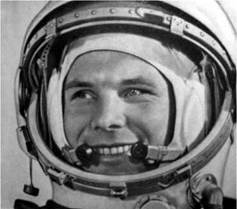Orbital space flight
In simple terms to attain true flight into space and achieve at least one orbit of Earth requires sufficient velocity and altitude to “fall” towards the planet in a closed orbit, which, as the surface curves away, is sufficient to loop around as long as the velocity and altitude is sustained. If not gravity will take over and the increasing density of the layers of the atmosphere drag the vehicle down towards the Earth once again. To escape low Earth orbit requires additional velocity “boosts” to increase speed to higher orbits or out towards the Moon or planets, using the gravitational forces of those celestial objects and the momentum of the vehicle to allow the spacecraft to journey towards them.
|
Yuri A. Gagarin, the first human space explorer. |











